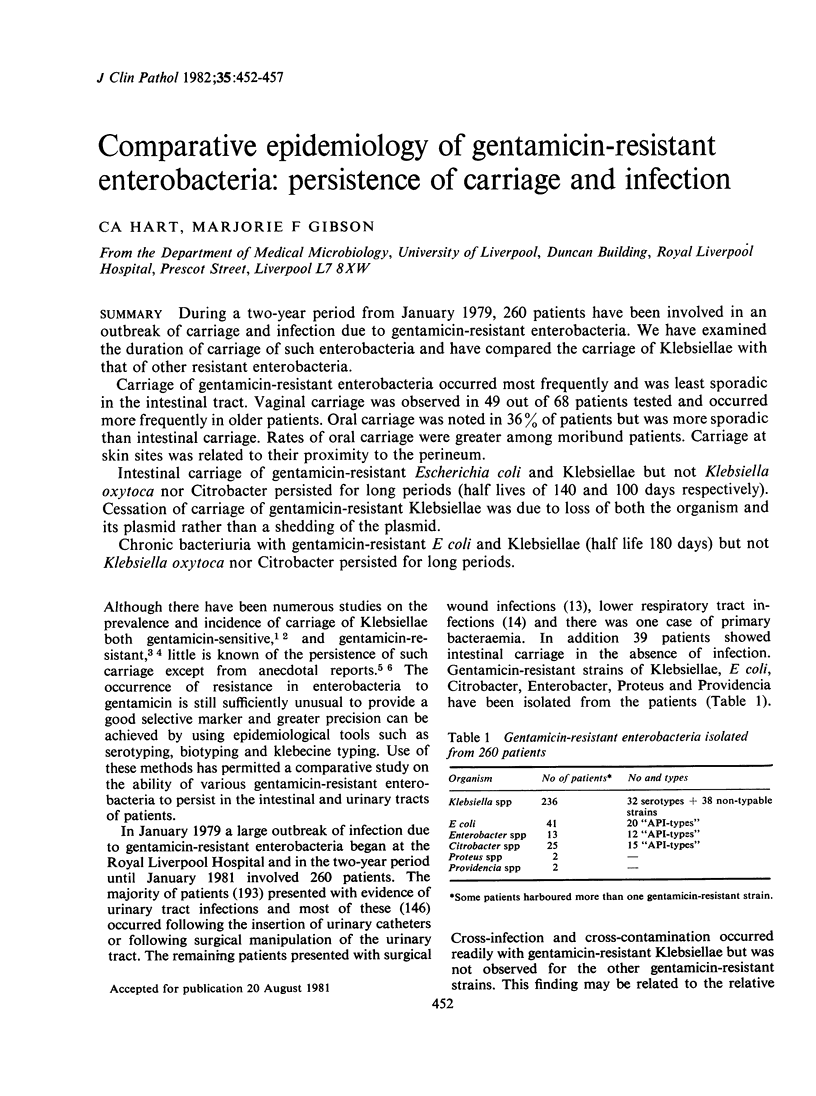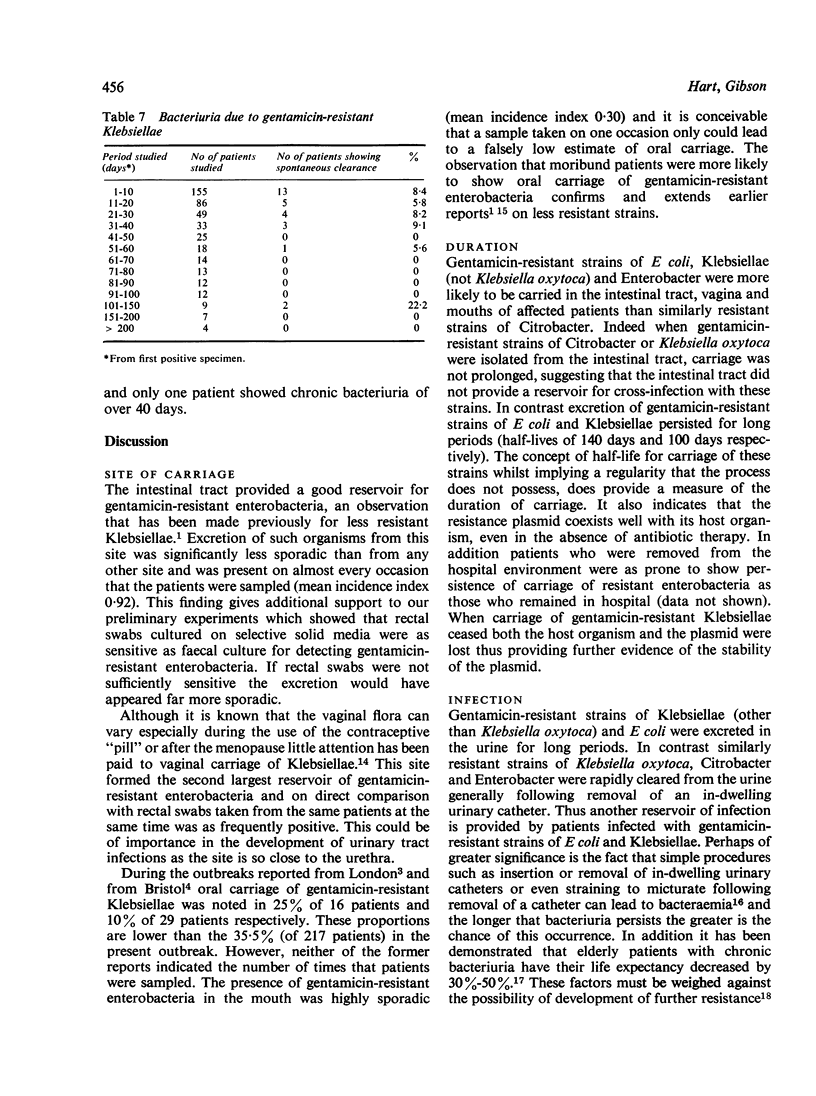Abstract
During a two-year period from January 1979, 260 patients have been involved in an outbreak of carriage and infection due to gentamicin-resistant enterobacteria. We have examined the duration of carriage of such enterobacteria and have compared the carriage of Klebsiella with that of other resistant enterobacteria. Carriage of gentamicin-resistant enterobacteria occurred most frequently and was least sporadic in the intestinal tract. Vaginal carriage was observed in 49 out of 68 patients tested and occurred more frequently in older patients. Oral carriage was noted in 36% of patients but was more sporadic than intestinal carriage. Rates of oral carriage were greater among moribund patients. Carriage at skin sites was related to their proximity to the perineum. Intestinal carriage of gentamicin-resistant Escherichia coli and Klebsiellae but not Klebsiella oxytoca nor Citrobacter persisted for long periods (half lives of 140 and 100 days respectively). Cessation of carriage of gentamicin-resistant Klebsiellae was due to loss of both the organism and its plasmid rather than a shedding of the plasmid. Chronic bacteriuria with gentamicin-resistant E coli and Klebsiellae (half life 180 days) but not Klebsiella oxytoca nor Citrobacter persisted for long periods.
Full text
PDF





Selected References
These references are in PubMed. This may not be the complete list of references from this article.
- Casewell M. W., Dalton M. T., Webster M., Phillips I. Gentamicin-resistant Klebsiella aerogenes in a urological ward. Lancet. 1977 Aug 27;2(8035):444–446. doi: 10.1016/s0140-6736(77)90621-3. [DOI] [PubMed] [Google Scholar]
- Casewell M. W. Titres and cross reactions of commercial antisera for the capsular typing of Klebsiella species. J Clin Pathol. 1975 Jan;28(1):33–36. doi: 10.1136/jcp.28.1.33. [DOI] [PMC free article] [PubMed] [Google Scholar]
- Cooke E. M., Brayson J. C., Edmondson A. S., Hall D. An investigation into the incidence and sources of klebsiella infections in hospital patients. J Hyg (Lond) 1979 Jun;82(3):473–480. doi: 10.1017/s0022172400053997. [DOI] [PMC free article] [PubMed] [Google Scholar]
- Cooke E. M., Pool R., Brayson J. C., Edmondson A. S., Munro M. E., Shinebaum R. Further studies on the sources of Klebsiella aerogenes in hospital patients. J Hyg (Lond) 1979 Dec;83(3):391–395. doi: 10.1017/s0022172400026218. [DOI] [PMC free article] [PubMed] [Google Scholar]
- Corbishley C. M. Microbial flora of the vagina and cervix. J Clin Pathol. 1977 Aug;30(8):745–748. doi: 10.1136/jcp.30.8.745. [DOI] [PMC free article] [PubMed] [Google Scholar]
- Curie K., Speller D. C., Simpson R. A., Stephens M., Cooke D. I. A hospital epidemic caused by gentamicin-resistant Klebsiella aerogenes. J Hyg (Lond) 1978 Feb;80(1):115–123. doi: 10.1017/s0022172400053432. [DOI] [PMC free article] [PubMed] [Google Scholar]
- Donovan T. J. A Klebsiella screening medium. J Med Lab Technol. 1966 Jul;23(3):194–197. [PubMed] [Google Scholar]
- Dontas A. S., Kasviki-Charvati P., Papanayiotou P. C., Marketos S. G. Bacteriuria and survival in old age. N Engl J Med. 1981 Apr 16;304(16):939–943. doi: 10.1056/NEJM198104163041604. [DOI] [PubMed] [Google Scholar]
- Hart C. A., Desmond A. D., Percival A. Treatment of gentamicin-resistant Klebsiella urinary tract infections with cephradine, augmentin, cefuroxime and amikacin. J Antimicrob Chemother. 1981 Sep;8(3):231–237. doi: 10.1093/jac/8.3.231. [DOI] [PubMed] [Google Scholar]
- Hart C. A., Gibson M. F., Buckles A. M. Variation in skin and environmental survival of hospital gentamicin-resistant enterobacteria. J Hyg (Lond) 1981 Oct;87(2):277–285. doi: 10.1017/s0022172400069497. [DOI] [PMC free article] [PubMed] [Google Scholar]
- Houang E. T., Casewell M. W., Simms P. A., Horton R. A. Hospital-acquired faecal klebsiellae as source of multiple resistance in the community. Lancet. 1980 Jan 19;1(8160):148–149. doi: 10.1016/s0140-6736(80)90626-1. [DOI] [PubMed] [Google Scholar]
- Johanson W. G., Pierce A. K., Sanford J. P. Changing pharyngeal bacterial flora of hospitalized patients. Emergence of gram-negative bacilli. N Engl J Med. 1969 Nov 20;281(21):1137–1140. doi: 10.1056/NEJM196911202812101. [DOI] [PubMed] [Google Scholar]
- Palfreyman J. M. Klebsiella serotyping by counter-current immunoelectrophoresis. J Hyg (Lond) 1978 Oct;81(2):219–225. doi: 10.1017/s0022172400025043. [DOI] [PMC free article] [PubMed] [Google Scholar]
- Selden R., Lee S., Wang W. L., Bennett J. V., Eickhoff T. C. Nosocomial klebsiella infections: intestinal colonization as a reservoir. Ann Intern Med. 1971 May;74(5):657–664. doi: 10.7326/0003-4819-74-5-657. [DOI] [PubMed] [Google Scholar]
- Selden R., Lee S., Wang W. L., Bennett J. V., Eickhoff T. C. Nosocomial klebsiella infections: intestinal colonization as a reservoir. Ann Intern Med. 1971 May;74(5):657–664. doi: 10.7326/0003-4819-74-5-657. [DOI] [PubMed] [Google Scholar]
- Slade N. Postoperative urinary tract infections in urology and gynaecology: a review. J R Soc Med. 1980 Oct;73(10):739–743. doi: 10.1177/014107688007301011. [DOI] [PMC free article] [PubMed] [Google Scholar]


